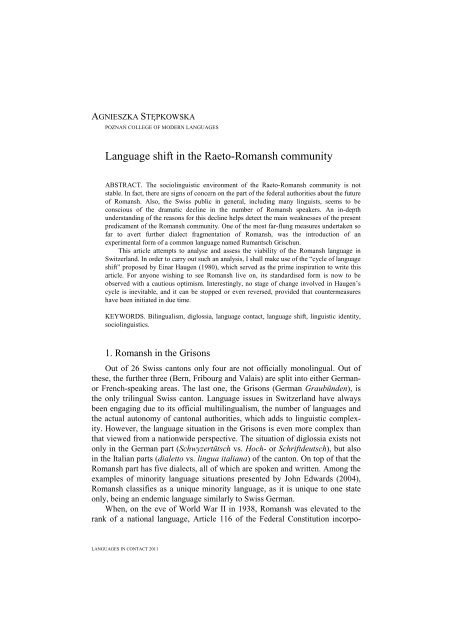s - Wyższa SzkoÅa Filologiczna we WrocÅawiu
s - Wyższa SzkoÅa Filologiczna we WrocÅawiu
s - Wyższa SzkoÅa Filologiczna we WrocÅawiu
You also want an ePaper? Increase the reach of your titles
YUMPU automatically turns print PDFs into web optimized ePapers that Google loves.
AGNIESZKA STĘPKOWSKA<br />
POZNAŃ COLLEGE OF MODERN LANGUAGES<br />
Language shift in the Raeto-Romansh community<br />
ABSTRACT. The sociolinguistic environment of the Raeto-Romansh community is not<br />
stable. In fact, there are signs of concern on the part of the federal authorities about the future<br />
of Romansh. Also, the Swiss public in general, including many linguists, seems to be<br />
conscious of the dramatic decline in the number of Romansh speakers. An in-depth<br />
understanding of the reasons for this decline helps detect the main <strong>we</strong>aknesses of the present<br />
predicament of the Romansh community. One of the most far-flung measures undertaken so<br />
far to avert further dialect fragmentation of Romansh, was the introduction of an<br />
experimental form of a common language named Rumantsch Grischun.<br />
This article attempts to analyse and assess the viability of the Romansh language in<br />
Switzerland. In order to carry out such an analysis, I shall make use of the “cycle of language<br />
shift” proposed by Einar Haugen (1980), which served as the prime inspiration to write this<br />
article. For anyone wishing to see Romansh live on, its standardised form is now to be<br />
observed with a cautious optimism. Interestingly, no stage of change involved in Haugen’s<br />
cycle is inevitable, and it can be stopped or even reversed, provided that countermeasures<br />
have been initiated in due time.<br />
KEYWORDS. Bilingualism, diglossia, language contact, language shift, linguistic identity,<br />
sociolinguistics.<br />
1. Romansh in the Grisons<br />
Out of 26 Swiss cantons only four are not officially monolingual. Out of<br />
these, the further three (Bern, Fribourg and Valais) are split into either Germanor<br />
French-speaking areas. The last one, the Grisons (German Graubünden), is<br />
the only trilingual Swiss canton. Language issues in Switzerland have always<br />
been engaging due to its official multilingualism, the number of languages and<br />
the actual autonomy of cantonal authorities, which adds to linguistic complexity.<br />
Ho<strong>we</strong>ver, the language situation in the Grisons is even more complex than<br />
that vie<strong>we</strong>d from a nationwide perspective. The situation of diglossia exists not<br />
only in the German part (Schwyzertütsch vs. Hoch- or Schriftdeutsch), but also<br />
in the Italian parts (dialetto vs. lingua italiana) of the canton. On top of that the<br />
Romansh part has five dialects, all of which are spoken and written. Among the<br />
examples of minority language situations presented by John Edwards (2004),<br />
Romansh classifies as a unique minority language, as it is unique to one state<br />
only, being an endemic language similarly to Swiss German.<br />
When, on the eve of World War II in 1938, Romansh was elevated to the<br />
rank of a national language, Article 116 of the Federal Constitution incorpo-<br />
LANGUAGES IN CONTACT 2011
















